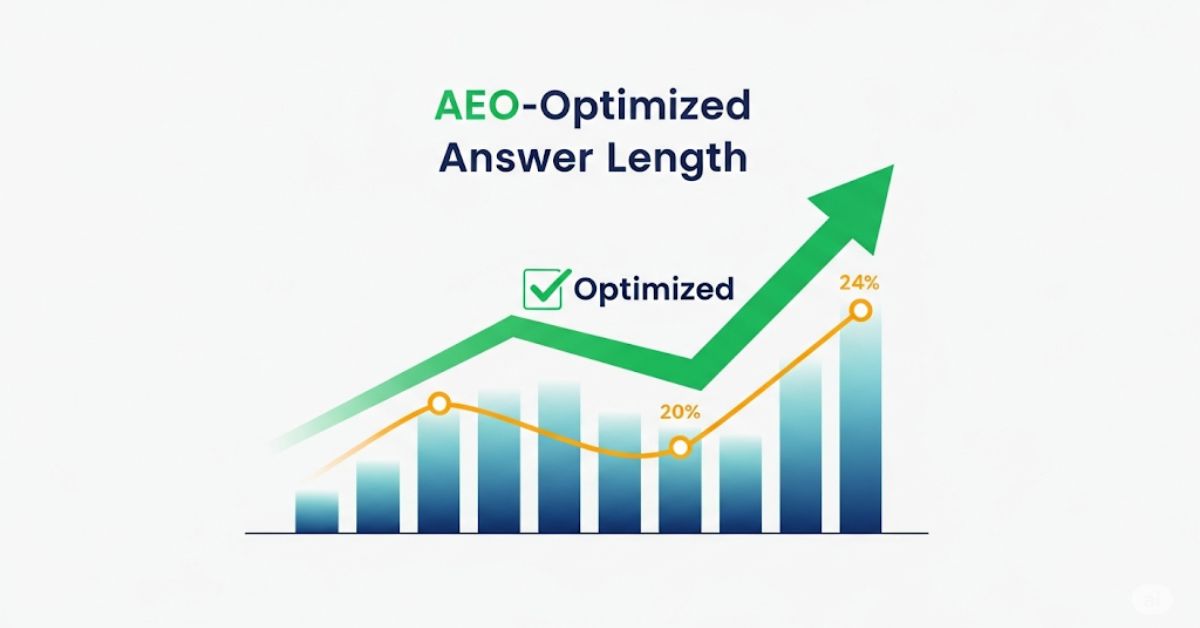Answer Engine Optimization (AEO) is transforming how we create and structure online content. In a digital world where users expect fast, accurate answers, delivered directly through voice assistants, AI chatbots, and smart search engines, content creators must adapt their strategies. AEO aims to deliver the best possible response directly within search engine results, without the need for users to click through to a website.
Among the many elements that influence success in AEO, the length of the answer plays a vital role. If the answer is too short, it may lack substance or context; if it’s too long, it may overwhelm or get truncated. So, what is the ideal answer length for AEO? This article dives deep into this question, covering different use cases, practical recommendations, search behavior insights, and optimization strategies.
What Is AEO and Why Does Answer Length Matter?
Answer Engine Optimization refers to a content strategy that focuses on crafting responses tailored to how users interact with modern search technologies. These technologies include Google’s Featured Snippets and People Also Ask boxes, Bing’s AI-powered search, OpenAI’s ChatGPT, Google’s Search Generative Experience (SGE), and voice-activated tools like Siri and Alexa. Unlike traditional SEO, where the goal is often to rank high in search listings, AEO centers on creating a direct, accurate, and machine-readable answer that satisfies a user’s intent immediately.
The significance of AEO has grown with the rise of zero-click searches. In these cases, users find the information they need directly on the search results page, often through a snippet, a definition, or a voice response. If your content is optimized properly for these answers, it can dramatically increase visibility and authority, even if users don’t click through to your site. But for this to happen, the content must strike the right balance in length: not too shallow, and not too verbose.
How Long Should an AEO Answer Be?
There is no one-size-fits-all word count when it comes to AEO, but patterns have emerged based on how search engines and AI tools extract and display information. The ideal length often depends on the type of query, the platform used, and how users prefer to consume information.
Short Answers: 40–90 Words
Short-form answers typically range between 40 and 90 words. These are ideal for direct, factual questions. They tend to perform well in voice search results and featured snippet boxes, which favor content that can be read aloud or displayed quickly. For example, when someone asks, “What is AEO?”, the optimal answer is one that defines the term succinctly, includes relevant keywords early, and leaves little room for ambiguity. These short answers often appear at the top of search results or are spoken by virtual assistants.
Medium-Length Answers: 100–150 Words
For more nuanced questions, a slightly longer response is required, usually between 100 and 150 words. These mid-length answers provide room to elaborate slightly, define terms, give brief context, or introduce a two- to three-point explanation. This format is well-suited for Google’s “People Also Ask” boxes or AI overviews that blend multiple sources to construct an ideal response.
Long Answers: 250–400+ Words
Then there are cases where even more detail is appropriate, particularly for complex, strategic, or multi-step questions. In these situations, long-form answers of 250 to 400+ words are more effective. This is especially true for expert guides, technical topics, and competitive analyses where the user wants more than just a summary, they want actionable insight. While these answers may not always appear directly in voice search or snippets, they are increasingly being used as source material by AI platforms like ChatGPT or Google SGE when generating summary content.
Matching Answer Length to User Intent
Choosing the right length for your answer depends heavily on user intent. For straightforward, informational questions such as definitions, short answers are more appropriate. These include questions like “What is Domain Authority?”, “What does HTTP stand for?”, or “Is AEO part of SEO?”. In these cases, users are expecting a quick, reliable response, ideally within 1–2 sentences. Writing more than necessary not only reduces clarity but may also disqualify the content from appearing in search snippets or voice replies.
In contrast, questions that indicate a desire for explanation, comparison, or step-by-step instruction require longer answers. For example, queries like “How does AEO impact e-commerce SEO?” or “What are the benefits of structured data for AEO?” signal that the user wants to learn something, not just get a fact. Here, a longer answer that covers the key components, explaining concepts, examples, implications, and next steps, is better suited.
A smart way to balance both is to use a two-tiered approach: begin with a concise 1–2 sentence summary that could qualify for a snippet, then expand into a longer section that gives more context and elaborates on points. This ensures that both search engines and users get what they need, regardless of whether they are looking for a quick fix or in-depth guidance.
Why Structure and Formatting Are Just as Important
Even if your content length is appropriate, poor formatting can make it invisible to AI engines. Modern search technologies and AI tools rely on content that is not only accurate but also well-structured.
One of the most effective techniques is to place the answer as close to the top of the page or section as possible. This ensures that both users and AI crawlers find the information without needing to scroll or parse unnecessary introductory text. Using clear headings (H2 or H3 tags) is also important, as it signals topic hierarchy and helps break down the page into logical sections.
Another strategy is to begin each section or paragraph with a direct, clear answer to the question, followed by additional explanation. This “answer-first” model helps search engines extract the most relevant information quickly.
While bullet points and lists are often used, they should be applied thoughtfully. Overuse can dilute clarity. Instead, use paragraphs to elaborate thoughtfully on each idea, reserving lists for multi-step processes or feature comparisons. Similarly, tables can be useful when presenting data or comparing features but are not always suitable for general content.
Lastly, incorporating structured data through schema markup can significantly increase your chances of being featured. Schema types like FAQPage, HowTo, Article, and Product help search engines understand the content’s purpose, making it easier to select your content as a trusted answer.
How AI Engines Process Content and Measure Answer Quality
Understanding how search engines and AI read content gives us important insight into what makes an answer effective. These systems use Natural Language Processing (NLP) to interpret content. NLP algorithms look for clarity, conciseness, structure, and semantic relevance.
The simpler and more declarative your sentences, the easier they are for NLP systems to interpret. Passive voice, jargon, or long-winded expressions reduce readability and increase the chance that the answer will be misinterpreted or ignored.
Context is another major factor. AI does not extract content in isolation. It evaluates the surrounding text to verify the accuracy and relevance of a section. Therefore, answers should be embedded in clearly written, semantically rich content that reflects a deep understanding of the topic. Including related terms, synonyms, and contextually connected concepts helps AI grasp your content’s meaning more fully.
Finally, the position of the answer matters. Content placed at the beginning of the section or in the first 100 words of a page is more likely to be indexed and featured. AI models often prioritize early content when constructing summaries or selecting featured excerpts.
Testing and Refining Your AEO Answer Length
To find the optimal answer length for your content, you should regularly test and refine your approach using both SEO tools and manual methods.
Start with a basic SERP analysis. Search your target query in Google and note the length of answers in the Featured Snippet and People Also Ask sections. This provides a benchmark. Often, you’ll find that top results fall within the 40–120 word range.
Next, use advanced content optimization tools. Platforms like Frase.io provide insights into the average word count of high-ranking answers. Surfer SEO analyzes competitors’ content and recommends ideal lengths for each section based on keyword and NLP data. Clearscope helps ensure clarity and keyword relevance, guiding your content toward both human readability and AI recognition.
Another highly practical method is manual testing in AI platforms. Paste your answer into ChatGPT or run a prompt in Google’s Search Generative Experience. Observe how the AI summarizes your content or selects portions to display. Based on this feedback, you can refine your sentence structure, adjust length, and reword content to improve its performance.
Common Mistakes That Hurt AEO Visibility
Even experienced writers can fall into traps that reduce the effectiveness of AEO-optimized answers.
One common mistake is over-explaining simple questions. If a user wants to know what an XML Sitemap is, they likely need a basic 1–2 sentence explanation, not a 500-word history of web crawling. Giving too much information can result in the answer being ignored.
Another issue is failing to align with user intent. A content piece written for the keyword “What is an SEO audit?” shouldn’t turn into an essay about the entire SEO industry. Clarity, context, and relevance are more valuable than sheer word count.
Other mistakes include keyword stuffing, neglecting proper formatting, skipping schema markup, or burying answers deep within a lengthy article. Each of these errors can reduce the chances of your content being selected by AI engines, regardless of quality.
Conclusion
The ideal length of an AEO-optimized answer depends on the context and user intent. For voice search or direct definitions, 40–90 words works best. For slightly deeper answers, aim for 100–150 words. For complex questions and AI-powered summaries, 250+ words are more suitable.
The key is to write clearly, concisely, and strategically. Structure your content with direct answers, followed by detailed explanations. Use headings, schema markup, and answer-first formatting to guide AI engines. Test different formats using SEO tools and live AI platforms to see what works best.
In AEO, it’s not just about how much you say, it’s about how effectively you say it. Balance clarity with completeness, and you’ll be ready to win in the future of search.



